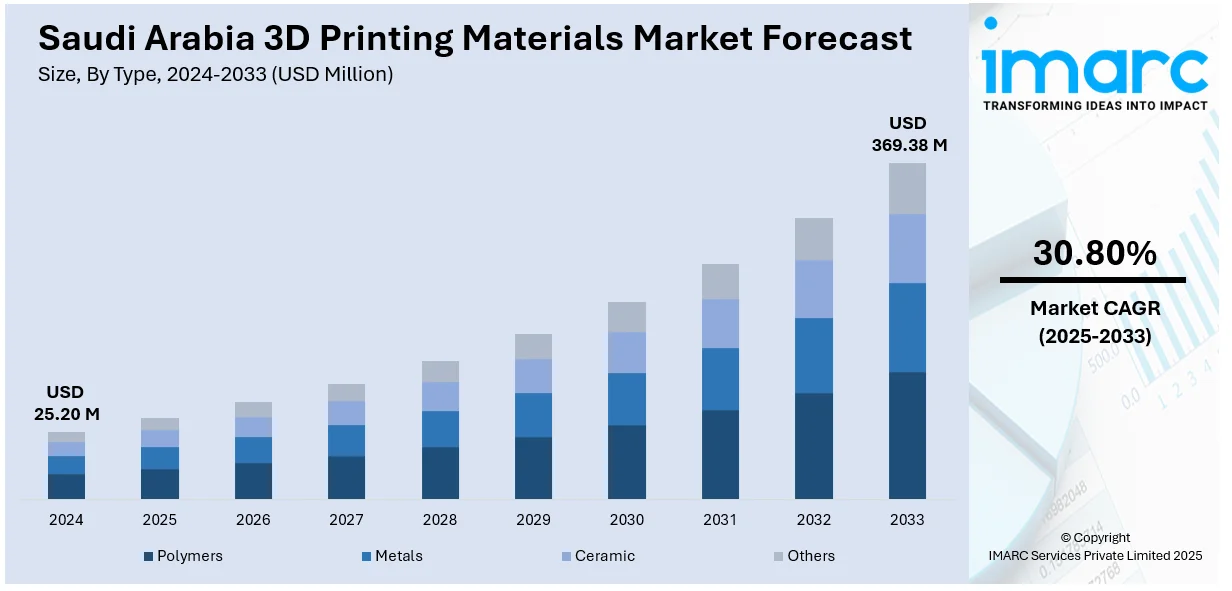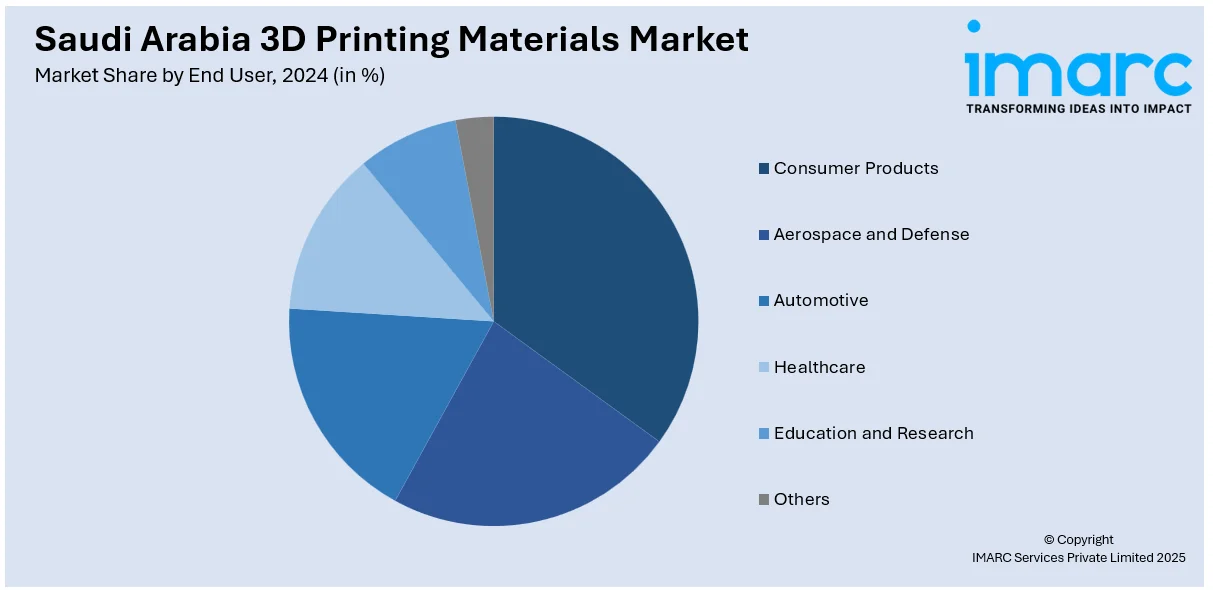
Saudi Arabia 3D Printing Materials Market Size, Share, Trends and Forecast by Type, Form, End User, and Region, 2025-2033
Saudi Arabia 3D Printing Materials Market Overview:
The Saudi Arabia 3D printing materials market size reached USD 25.20 Million in 2024. Looking forward, IMARC Group expects the market to reach USD 369.38 Million by 2033, exhibiting a growth rate (CAGR) of 30.80% during 2025-2033. At present, businesses are utilizing 3D printing materials to create lightweight automotive parts, improving fuel efficiency and overall performance. The technology provides enhanced design versatility, allowing car manufacturers to produce tailored components and decrease dependency on conventional tooling. Besides this, the growing establishment of healthcare facilities is contributing to the expansion of the Saudi Arabia 3D printing materials market share.
|
Report Attribute
|
Key Statistics
|
|---|---|
|
Base Year
|
2024 |
|
Forecast Years
|
2025-2033
|
|
Historical Years
|
2019-2024
|
| Market Size in 2024 | USD 25.20 Million |
| Market Forecast in 2033 | USD 369.38 Million |
| Market Growth Rate 2025-2033 | 30.80% |
Saudi Arabia 3D Printing Materials Market Trends:
Growing applications in automotive industry
Rising applications of 3D printing materials in the automotive industry are stimulating the market growth. With rising vehicle production, the demand for 3D printing materials is increasing. As per industry reports, in 2024, 827,857 fresh light vehicles were introduced to Saudi roads, reflecting a robust 6.6% rise from 2023. As the automotive sector in the country continues to modernize and innovate, manufacturers are adopting 3D printing for designing, prototyping, and producing complex parts with greater precision and reduced lead times. Companies are using 3D printing to develop lightweight components, which help improve fuel efficiency and performance. The technology allows greater design flexibility, enabling automakers to create custom parts and reduce reliance on traditional tooling. This shift is reducing production costs and speeding up item development cycles. 3D printing also supports localized manufacturing, which aligns with Saudi Arabia’s Vision 2030 goals of industrial diversification and domestic production growth. As automotive research and development (R&D) activities are growing in the region, the demand for high-quality 3D printing materials like thermoplastics, resins, and metal powders is increasing. The technology also supports rapid prototyping, which enables engineers to test multiple iterations quickly and efficiently. Luxury and electric vehicle (EV) segments are gaining significantly from the design freedom and material efficiency offered by 3D printing. Moreover, aftermarket services in the automotive industry, which includes the production of spare parts, also benefit from on-demand printing solutions.

Expansion of dentistry services
The broadening of dentistry services is impelling the Saudi Arabia 3D printing materials market growth. As dental clinics and healthcare facilities are expanding across the country, the demand for advanced and efficient dental solutions is increasing. Dentists are employing 3D printing materials to create precise dental implants, crowns, bridges, aligners, and dentures. This technology helps improve patient outcomes by offering custom-fit solutions in a shorter time frame. With more clinics adopting digital workflows, the need for high-quality 3D printing materials, such as resins and polymers, is rising steadily. These materials are essential for creating accurate and durable dental models and appliances. 3D printing also reduces the cost and time involved in traditional dental procedures, making it a preferred choice for modern dental practices. As cosmetic and restorative dentistry is gaining popularity, clinics continue to rely more on 3D printed tools for better aesthetics and performance. Dental labs are utilizing the technology to increase efficiency and minimize manual errors. With a growing population and rising awareness about oral health, the expansion of dentistry services is supporting the growth of the market in Saudi Arabia. According to the Worldometer, as of May 18, 2025, the population of Saudi Arabia was 34,488,920.
Saudi Arabia 3D Printing Materials Market Segmentation:
IMARC Group provides an analysis of the key trends in each segment of the market, along with forecasts at the country and regional levels for 2025-2033. Our report has categorized the market based on type, form, and end user.
Type Insights:
- Polymers
- Acrylonitrile Butadiene Styrene (ABS)
- Polylactic Acid (PLA)
- Photopolymers
- Nylon
- Others
- Metals
- Steel
- Titanium
- Aluminum
- Others
- Ceramic
- Silica Sand
- Glass
- Gypsum
- Others
- Others
The report has provided a detailed breakup and analysis of the market based on the type. This includes polymers (acrylonitrile butadiene styrene (ABS), polylactic acid (PLA), photopolymers, nylon, and others), metals (steel, titanium, aluminum, and others), ceramic (silica sand, glass, gypsum, and others), and others.
Form Insights:
- Powder
- Filament
- Liquid
A detailed breakup and analysis of the market based on the form have also been provided in the report. This includes powder, filament, and liquid.
End User Insights:

- Consumer Products
- Aerospace and Defense
- Automotive
- Healthcare
- Education and Research
- Others
The report has provided a detailed breakup and analysis of the market based on the end user. This includes consumer products, aerospace and defense, automotive, healthcare, education and research, and others.
Regional Insights:
- Northern and Central Region
- Western Region
- Eastern Region
- Southern Region
The report has also provided a comprehensive analysis of all the major regional markets, which include Northern and Central Region, Western Region, Eastern Region, and Southern Region.
Competitive Landscape:
The market research report has also provided a comprehensive analysis of the competitive landscape. Competitive analysis such as market structure, key player positioning, top winning strategies, competitive dashboard, and company evaluation quadrant has been covered in the report. Also, detailed profiles of all major companies have been provided.
Saudi Arabia 3D Printing Materials Market News:
- In January 2025, Roboze teamed up with SLB to establish local production capabilities for non-metallic 3D printed components in Saudi Arabia. This alliance created a mutual commitment to utilize Roboze's additive manufacturing technologies for on-demand production of SLB-qualified components.
- In July 2024, National Additive Manufacturing & Innovation (NAMI) Company, a 3D printing service provider located in Saudi Arabia, acquired several metal and polymer 3D printers from 3D Systems. NAMI and Dussur aimed to utilize the new systems to manufacture components for the Saudi Electricity Company (SEC). The collaboration involved NAMI developing a digital catalog of components to minimize production duration, physical storage needs, and expenses. Merging the reverse engineering of outdated parts with additive manufacturing could enhance the operational time and lifespan of machinery.
Saudi Arabia 3D Printing Materials Market Report Coverage:
| Report Features | Details |
|---|---|
| Base Year of the Analysis | 2024 |
| Historical Period | 2019-2024 |
| Forecast Period | 2025-2033 |
| Units | Million USD |
| Scope of the Report |
Exploration of Historical Trends and Market Outlook, Industry Catalysts and Challenges, Segment-Wise Historical and Future Market Assessment:
|
| Types Covered |
|
| Forms Covered | Powder, Filament, Liquid |
| End Users Covered | Consumer Products, Aerospace and Defense, Automotive, Healthcare, Education and Research, Others |
| Regions Covered | Northern and Central Region, Western Region, Eastern Region, Southern Region |
| Customization Scope | 10% Free Customization |
| Post-Sale Analyst Support | 10-12 Weeks |
| Delivery Format | PDF and Excel through Email (We can also provide the editable version of the report in PPT/Word format on special request) |
Key Questions Answered in This Report:
- How has the Saudi Arabia 3D printing materials market performed so far and how will it perform in the coming years?
- What is the breakup of the Saudi Arabia 3D printing materials market on the basis of type?
- What is the breakup of the Saudi Arabia 3D printing materials market on the basis of form?
- What is the breakup of the Saudi Arabia 3D printing materials market on the basis of end user?
- What is the breakup of the Saudi Arabia 3D printing materials market on the basis of region?
- What are the various stages in the value chain of the Saudi Arabia 3D printing materials market?
- What are the key driving factors and challenges in the Saudi Arabia 3D printing materials market?
- What is the structure of the Saudi Arabia 3D printing materials market and who are the key players?
- What is the degree of competition in the Saudi Arabia 3D printing materials market?
Key Benefits for Stakeholders:
- IMARC’s industry report offers a comprehensive quantitative analysis of various market segments, historical and current market trends, market forecasts, and dynamics of the Saudi Arabia 3D printing materials market from 2019-2033.
- The research report provides the latest information on the market drivers, challenges, and opportunities in the Saudi Arabia 3D printing materials market.
- Porter's five forces analysis assist stakeholders in assessing the impact of new entrants, competitive rivalry, supplier power, buyer power, and the threat of substitution. It helps stakeholders to analyze the level of competition within the Saudi Arabia 3D printing materials industry and its attractiveness.
- Competitive landscape allows stakeholders to understand their competitive environment and provides an insight into the current positions of key players in the market.
Need more help?
- Speak to our experienced analysts for insights on the current market scenarios.
- Include additional segments and countries to customize the report as per your requirement.
- Gain an unparalleled competitive advantage in your domain by understanding how to utilize the report and positively impacting your operations and revenue.
- For further assistance, please connect with our analysts.
 Request Customization
Request Customization
 Speak to an Analyst
Speak to an Analyst
 Request Brochure
Request Brochure
 Inquire Before Buying
Inquire Before Buying




.webp)




.webp)












